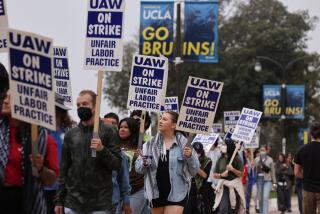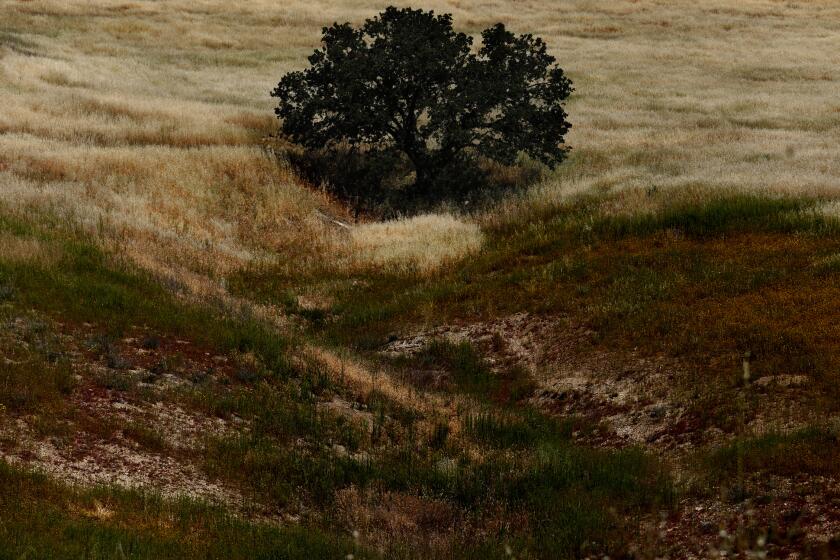Exploratory Oil Drilling Near Dodger Park Stalled
An exploratory oil drilling operation near Dodger Stadium has gained approval from the city and from most area residents, but concern over the long-term implications of possible oil production in the area--particularly for nearby Elysian Park--has delayed work on the project.
Petroleum Land Services of Bakersfield gained city permission last summer to drill two exploratory wells on a city parcel on Stadium Way that is used for overflow parking. Such exploratory ventures are about a once-a-year occurrence in the oil-rich Los Angeles Basin, according to petroleum experts.
“We’ve identified this area as worthy of exploration,” said Gale Simmons, president of the contract land service company. “Now, we have to identify what’s there and whether there is enough to make it worth the cost” of development.
200-Acre Area
But before the exploratory work begins, the firm hopes to gain lease agreements for subsurface rights from property owners in a 200-acre area targeted as potentially oil rich. The agreements would guarantee the company oil rights to the area, should the company find it profitable to drill.
“We’re not in the business of drilling wells and improving property for somebody else to come along” and profit from it, Simmons said in an interview last week. If the company decides to proceed with commercial oil drilling in the area, it would first have to go through a series of public hearings and gain city approval to form an oil drilling district.
Over the last year, the company has signed leases with about 375 area residents, or about 85% of private property owners in the neighborhood, Simmons said.
The area, generally bordered by Stadium Way on the east, the Hollywood and Pasadena freeways on the south, and Douglas Street on the north, is a transitional neighborhood with old, single-family homes giving way to apartments and condominiums. Only a few Italian and Slavic residents remain in the neighborhood, which in recent years has become home to a predominantly Asian population.
The only sizable hold-out in signing a lease agreement is the city Recreation and Parks Department, which owns the mineral rights to a 22-acre parcel along Stadium Way.
The proposal has twice gone before the city department’s Board of Commissioners, which has yet to take action. Most recently, the board postponed a decision at the request of Councilwoman Gloria Molina, who asked for more time to study the issue.
“There’s community concern about potential oil spills and about placing crucial parklands at risk,” Molina spokeswoman Alma Martinez said. She said the councilwoman also wants to review the terms of the leasing agreements, which provide a 16.6% share of oil profits to be divided among property owners.
“We want to deal with these issues now. It will be more difficult to say no when oil has already been found,” Martinez said.
A third hearing on the matter before the parks department is scheduled for early January.
Project Opponents
Opponents of the project include the Citizens Committee to Save Elysian Park, which has vigilantly protected the 575-acre hillside park from a number of potential intruders, including an airport and proposed oil drilling by Occidental Petroleum in the 1970s.
Past President Geneva Williams, 71, recalled the group’s first battle more than 20 years ago when it successfully fought the proposed construction of a city convention center in the heart of Elysian Park.
“We felt once we had won that battle that we could sit back and relax, but that wasn’t the case,” Williams said. “There’s been one battle after another.”
Although the proposed oil drilling area lies outside Elysian Park, the group is nevertheless concerned about possible future impact on the park and it will keep a watchful eye on the project, President Sallie Neubauer said.
“We’re suspicious that later on they might want to get into the park,” Neubauer said. “If this turns out to be a good oil field, it will invite exploration for more oil” in the area.
“There are too many unknowns. . . . The city should proceed with caution,” she said. Neubauer added that such potential problems as noise and air pollution have not been properly addressed.
Hank Ganio, an analyst with the city administrator’s office, said the CAO recommended approval of the Recreation and Parks Department lease.
“There will be ample opportunity to address the environmental issues residents seem most concerned about,” he said, noting that the city will require environmental impact reports and public hearings on the project.
For the oil company, the venture remains a $1-million gamble.
According to Simmons, the preliminary work on leasing agreements and exploratory work alone will cost about $1 million. He added that historically, one out of 10 exploratory wells results in the discovery of a profitable oil field.
‘No Guarantee’
“That’s a $1-million fee to get into the race and then there’s no guarantee that we’ll find anything,” he said.
But it is apparently worth the risk. The Los Angeles Basin, considered among the most prolific oil basins in the world, has been producing oil commercially for nearly a century, he said. During the 1920s, large oil fields were developed, including those at Signal Hill, in Wilmington and Torrance.
A new boom occurred during the 1960s and ‘70s, ushering in the age of “urban” oil drilling with discoveries in such unlikely places as Beverly Hills, Venice Beach and Hollywood Park.
Judging from other oil fields in the Dodger Stadium area, Simmons said that if a new field is found, he would anticipate drilling perhaps 10 wells on less than an acre of land.
Although there are a number of unknown factors determining the potential financial return to residents in the drilling area, Simmons offered a possible scenario. If the field is a relatively small one, producing about 4 million barrels of oil over a 10-year life span, it might generate about $80 million in gross income. He said that about $13 million of this would go into royalties, which divided among the property owners would provide about $33,000 for each.
More to Read
Start your day right
Sign up for Essential California for news, features and recommendations from the L.A. Times and beyond in your inbox six days a week.
You may occasionally receive promotional content from the Los Angeles Times.






